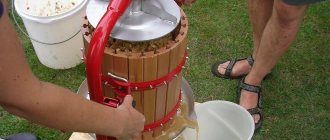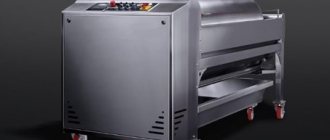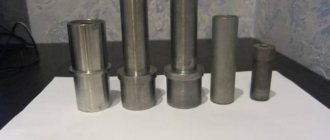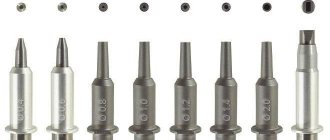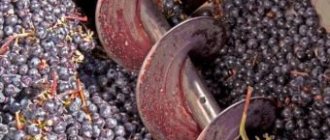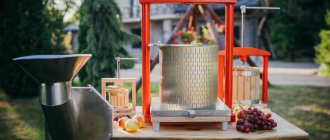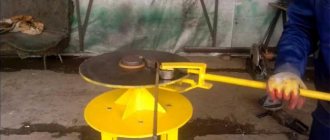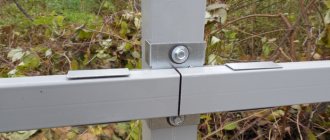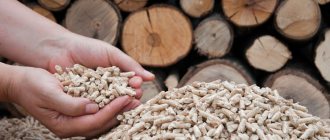Processing the harvest of berries and fruits is one of the most important tasks that not only farmers, but also owners of personal plots have to solve. Technical devices that greatly facilitate this process include a juice press, which allows you to quickly and without significant physical effort turn fruits and berries into tasty juice rich in vitamins. There is a wide variety of such devices on the modern market, but those home craftsmen who want to save money on purchasing them can easily make such a press with their own hands.
Extracting juice using a garden press
OTHER
Maturation and aging of wine
The end of the preparation of any wine is marked by its transparency (or there is turbidity that no longer descends), which...
Wine production - what a novice winemaker should know
Experienced winemakers have their own tricks and secrets that allow them to produce tasty and aromatic homemade wine year after year...
Wine production
Video: Winemaking, wine production in Spain (part 2) wine juice Wine is a fermentation product prepared in advance…
Preparing to make wine
Preparing grape wine starter 7–8 days before the start of the grape harvest, in dry weather, selectively harvest...
Equipment for home winemaking
ContentsPreparation of raw materials for winemakingCrushing grapesPressing raw materialsFermentationUsing water seals in…
The best homemade apple wine
Fans of classical literature have often come across mentions of such a drink as...
What equipment is needed for winemaking?
What equipment is needed for winemaking and what grape varieties are suitable? Winemaking is popular in our country.…
How to make homemade wine?
Winemaking traditions, carefully preserved by humanity, date back several thousand years. Useful qualities of grape…
How best to store homemade wine
Owners of a home vineyard often face a problem: how to store homemade grape wine so that its taste...
Making dry wine
There is an opinion among people that it is impossible to make dry wine at home without adding sugar due to its low...
Making wine from rowan at home
Wine connoisseurs will appreciate the delicious homemade red rowan wine. It is characterized by a slight bitterness,…
Making cranberry wine at home
Cranberry wine retains most of the beneficial properties of this northern berry; it contains many acids, vitamins and…
Making homemade red wine
A classic of the genre is homemade red wine, a drink with centuries-old traditions of preparation and consumption. Wherever...
Choosing a container for wine fermentation
Home winemaking is impossible without special containers in which fermentation takes place. It largely depends on the capacity...
Winemaking at home
ContentsHistory of home winemakingSecrets and features of home winemakingRaw materials for winemakingEquipment…
Apple wine recipe at home
Apples are an excellent raw material for making delicious wine yourself. The result is a wonderful alcoholic...
When to press and other winemaking decisions[edit]
The decision on when to press red grapes will have an impact on color, as color phenolic compounds and tannins are extracted from the grapes during maceration before pressing.
Pressing time and methods used will influence other decisions in the winemaking process. In white wine production, pressing usually occurs immediately after harvesting and crushing. The most important decision here will be how much pressure to apply and how much pressed juice winemakers want in addition to free juice. Some grape varieties, such as Semillon and Aurora, have very "liquid" pulp that releases juice easily without requiring much pressure, which can cause the skin to rupture. Other varieties, such as Catawba, have tougher flesh that requires more pressing. [7]
When making red wine, pressing time is one of the most important decisions in the wine production process, as it is at this point that maceration and phenolic extraction stop. Some winemakers use a sugar reduction scale (such as the Brix scale) and press once the wine is completely dry. Often, winemakers use taste to determine whether enough tannins have been released to produce a balanced wine, and may press until completely dry (eg 3-8 Brix). Although removing the skins by pressing often removes some of the solids that wine yeast needs to complete fermentation, the benefits of early pressing are often balanced by the risk of potentially stalling the fermentation.[4]
The quality of the harvest and the overall ripeness of the grapes harvested can also make a difference, as in cool years, when the grapes are often picked unripe, the tannins in the grapes are often very "green" and tough. During these years, winemakers can begin pressing early (at 15 Brix, for example), a process the Australians call “short tun.” In warmer years, the tannins may be fully ripe or "sweet" and the winemaker may decide to allow a period of extended maceration and not press the grapes for a month after fermentation is complete. [4]
Typically, pressed juice requires additional processing, which can be done separately from the pressed juice or from the entire batch of wine if the pressed juice is mixed with the pressed juice. These treatments may include acid adjustments to lower pH, extended settling periods to clarify and additional racking to remove excess suspended solids, and the use of fining agents to remove excess solids or excess tannins. The grape pulp contains a lot of pectins, which create colloidal coagulation with these solid particles, which will make it difficult to stabilize the wine. Some winemakers will use pectolytic enzymes during the maceration process to help break down the cell walls and allow more juice to be released freely. These enzymes are also used in white wines for clarification. [6] The type of pressing used and the amount of suspended solids plays a special role in filtration decisions, since large amounts of suspended solids (especially natural gums) can clog and damage expensive filters. [3]
Do it yourself
It is not uncommon for a full-fledged screw or other type of press to be replaced at home with food processors and juicers. You can squeeze juice from apples or grapes with them, but the result will not meet your expectations. The main problem with juicers and combines is that after processing the fruit, the juice does not clarify well or a lot of sediment is formed.
You can purchase a factory screw unit, which will have a positive effect on the results of the work done. However, many people do not want to spend money on something that they can easily assemble with their own hands.
Based on the drawings, photos and video instructions, you can assemble an excellent homemade press and squeeze out almost the entire harvest on it.
We offer you a fairly simple option for assembling a grape press, which will consist of scrap materials.
- Prepare any container suitable in volume and material into which the berries will be loaded. The best option is the drum of the washing machine. You need to make holes in the walls with a drill, acting in a checkerboard pattern.
- Prepare a container that is slightly larger than the washing machine drum. This is a cylindrical container without a bottom with additional holes at the bottom.
- Insert the smaller container into the larger one, and place a small wooden block between them. This will give you the required clearance.
- Make or find a U-shaped frame. Place the working part on the crossbar of the frame. This can be a thick pancake made of stainless metal or cast iron. This pancake, complete with a lever, is fixed by drilling a hole in the frame.
- Place two containers in a large bowl made from food grade polymers. Drill a hole in it, where you then connect the hose. The grape juice will flow out through this hose.
- A U-shaped horizontal bar concreted in the ground will act as the basis for the working mechanism. But the base is mounted on a structure consisting of a food basin and two cylinders with holes inserted into each other.
- The hose from the basin is placed at the other end into a container where the squeezed juice will accumulate.
- Load the grapes into the drum and cover with a wooden or stainless steel shield. A cast iron pancake is lowered on top of it, controlling the pressure with a lever.
- The juice released when pressing grapes or other fruits gradually flows through a hose into a storage container.
- It is recommended to press the pulp no more than 3 times.
Extra virgin juice is ideal for wine or a high quality fruit drink. The second and third pressings are used for simple alcoholic drinks. To achieve good quality wine without wasting the juice of the 2nd and 3rd pressings, simply mix them with the first pressing juice in certain proportions.
Advantages and disadvantages of use
• obtaining high-quality pulp that does not contain a large amount of components foreign to the product;
• rational use of energy and time;
• simple and durable design, which can be improved endlessly;
• the possibility of using improvised means when assembling the crusher;
• the use of stainless steel sheet material for assembling the unit reliably protects against the formation of rust during operation, and also prevents the formation of foreign odors in the juice.
The equipment does not have any significant drawbacks, except that it is not possible to use units with a destemming machine to obtain pulp from nutmeg varieties.
A grape crusher is a useful and practical unit for those involved in winemaking. Using such a device in wine production has a number of advantages:
- reduction in technological loss of pulp by several times;
- absence of saturation of the pulp with components undesirable for the final product;
- saving time and effort;
- obtaining higher quality pulp;
- the design of the unit is simple, reliable and very durable;
- a manual or mechanical crusher can be used in the absence of electricity;
- The high-quality stainless steel crusher is reliably protected from corrosion and does not impart any foreign odors to the grape juice.
- There are a number of advantages to working with a crusher:
- you can quickly obtain high-quality pulp without foreign impurities;
- significant savings in time and effort;
- the unit is simple and reliable to use;
- possibility of long-term use;
- less loss of pulp.
Disadvantages can be noted in crushers with a destemmer - they are not suitable for processing bunches of muscat varieties.
General tips and tricks
Before you start pruning grapes and preparing preparations from them, decide on your goal. Don't cut the entire vineyard at once. Without mechanical presses and crushers, it will be extremely difficult to cope with a large amount of raw materials in a short time. Also consider the following nuances:
Separate small branches
Pre-shred the grapes
Use wooden masher
Squeeze only fresh berries
Use ripe grapes
- To ensure that the juice does not have foreign flavor impurities, you need to separate the small branches on which the grapes are attached before sending the grapes to the press.
- To get the maximum amount of juice, the grapes should be crushed well, and only then put under the press.
- Metal presses oxidize the juice, so it can change its color and get a characteristic metallic taste.
- Never press rotting grapes that were not sold in a timely manner and are covered with a fungal coating. Such juice cannot be stored for a long time even after heat treatment.
- Juice obtained from unripe grapes lacks rich taste and aroma. No amount of sugar or flavorings can give it the qualities that nature has endowed it with.
Which hydraulic press to buy: tabletop or floor-mounted
When choosing a floor or tabletop type of device, you should first decide what the press is for.
The floor device is impressive in size. The instrument is located on the floor. It is used for processing large parts. The floor type hydraulic press is often chosen by large service stations whose main activity is car repair. Thanks to this device, the productivity of technological processes increases. In addition, the presence of a hydraulic press helps to expand the range of services provided.
Floor-standing hydraulic presses are designed for processing large parts
Floor-standing hydraulic presses are selected based on the characteristics of the hydraulic cylinder and the design parameters where it is installed. An important factor is the maximum force that the tool can exert on the workpiece being processed. This criterion varies between 5-20 tons. The effective operation of a floor press depends on the distance that the rod travels, acting on the part.
Features of Tabletop Hydraulic Press for Garage
The tabletop press is more stable. It features an extended range of desktop adjustment. This provides the ability to process parts of different sizes.
A tabletop hydraulic press is often chosen for a home workshop or garage. The maximum load capacity of the device reaches 12 tons. This tool is characterized by its small size and weight, which makes it easy to use. It can be installed on a workbench, which will save usable space.
Tabletop hydraulic press is ideal for the home workshop
When choosing a device, you should focus on the size and weight of the device, the type and characteristics of the working platform, which has different designs and dimensions. The design can be equipped with grooves for mounting additional elements. An important question is how much a press costs. A floor instrument can be purchased for 30 thousand rubles. The price of a tabletop hydraulic press averages 10-20 thousand rubles.
Some models have the ability to move the press along the frame relative to the rod. The tool may include shock-absorbing elements. They are necessary to compensate for the excess pressure that is exerted on the structure.
Related article:
When choosing a hydraulic press of any type, you should also take into account the material of manufacture and the thickness of the base plate of the device where the part is installed during its processing.
Tips for use
The quality of the resulting juice depends on how the grape press is made and how it is operated. Before starting work, the grapes must be washed, sorted, and the berries separated from the bunches; they do not need to be peeled. It gives juice and wine a pleasant bouquet.
Raw materials for pressing:
- whole berries, used for juice production;
- pulp, allows you to fully reveal the aroma of grapes, recommended for obtaining wine materials.
Sequence of actions when working with the press:
- Fix the device motionless on a horizontal, flat surface to avoid displacement.
- Prepare a container for collecting the pulp. This could be a bucket, tank, pan.
- Place a container under the outlet hose or chute into which the juice will drain.
- Place a plastic bag over the piston plate to prevent the piston from rubbing against solid pulp particles. Rotate the handle to set the screw to the top position.
- Cover the inner surface of the press basket with a clean, cold-water-washed, white, coarsely woven cloth (you can use material from flour or sugar sacks). The edges of the fabric should hang over the sides of the basket. This will make it easier to remove the pulp.
- Place pulp or berries in the basket, cover with the hanging corners of the fabric. Place the basket under the piston.
- Tighten the press screw until juice appears. Slowly turn the screw with the handle until significant resistance is felt.
- Stop the rotation of the screw. After a break of 30-60 seconds, start turning the screw again. This technology allows you to most fully open the cell membranes of grapes.
- After the juice stops flowing, use the handle to turn the screw to the top position.
- To better squeeze the grapes, repeat the process of rotating and stopping the screw 2-3 times.
- After the spin is completed, the press screw should be returned to its original position, turning it in the opposite direction.
- Remove the contents of the fabric from the basket. Transfer the pulp into a previously prepared container. Add a small amount of water so that it covers the cake by 1-2 cm. After 3-4 hours, warm the mixture to 65 degrees. This will allow you to extract as much juice as possible. Spin again. It is not recommended to squeeze the pulp more than three times; this leads to the accumulation of suspension in the wort.
- After completing the process, disassemble the device, clean all parts, rinse well, wipe and dry. To wash the basket, regardless of whether it is made of wood or metal, synthetic detergents should not be used. You can use soda or table salt.
- The press should be stored in a dry, ventilated area.
If a wooden basket becomes moldy, it should be washed with cold water and thoroughly brushed. Then you can prepare a solution of sulfuric acid (100 g per 2 liters of water) and wipe the entire surface of the basket with it, using a brush or piece of cloth. After two days, rinse with lye (an aqueous solution of wood ash) to neutralize the acid, then with clean water.
Read also: Simple landscape design for a small area in front of the house
Another way to get rid of mold is to coat the surface of the basket with lime. After two days, clean everything and rinse with water. Then treat the basket with sand and rinse with a solution of ammonia (3 tablespoons per 5 liters of water). If the mold is not old, you can scrape it off with a knife, then steam the basket with oak sawdust. Moldy parts of the press basket should not be washed with boiling water. This will cause the mold to eat into the wood surface.
Professional winemakers distinguish two types of juice used as wine material:
- obtained by gravity;
- isolated by pressing grapes.
How is the harvest done?
Experienced specialists advise harvesting grapes in three steps:
- A cut is made of the first 5-10 brushes, which in their qualities most closely correspond to mature ones. Those brushes that will be ready in 5-6 days are marked with ribbons.
- Prepared brushes that are already ripe and ready for harvesting are cut off.
- The remaining brushes are cut off, which are usually left for maximum ripening and saturation with sugars. These specimens are suitable for juice, wine and drying.
The technology for harvesting grapes is as follows:
Preparing the container
Paper
Shearing tool
Disinfection
Cutting time
- Preparing the container - it is best to take small plastic or wooden boxes in which the cut brushes are placed in one row. This will prevent the formation of wrinkled grapes. A layer of any paper must be placed on the bottom.
- Tool for cutting - woody brushes at their maximum maturity are quite difficult to separate from the mother vine. Therefore, it is more convenient to make the cut using garden pruners.
- Disinfection - pruner blades must be treated with any antiseptic that is on hand. This measure is necessary so that during the cutting process, pathogenic flora, which may be contained directly on the surface of the blades, does not enter the vine through the juice.
- Cutting time - the optimal time is from 8 to 10 am, when the morning dew has already subsided, but there is still no heat of the day.
It is not recommended to cut bunches in rainy and damp weather. Wet berries are poorly stored, and leaving cut vines in the rain increases the risk of developing a fungal infection.
Step-by-step actions
Armed with a pruning shears, you need to:
- Inspect the bunch, remove dry twigs, cut off spoiled grapes.
- Take the brush in your left hand from below, and with your right make a cut as close as possible to the mother vine.
- Carefully place the cut bunch into the prepared container, cut side up, so as not to damage neighboring bunches.
When the box is completely filled, it is placed in a cool place.
Further actions depend entirely on the purpose for which the grapes were grown. If this is a sale, then the sale of the goods must be carried out directly on the day of cutting.
On the 3-4th day of storage, some varieties with particularly thin skins begin to drain. Only those varieties that are intended for this purpose are taken for long-term storage.
Expert opinion
Evgeniy Georgievich Pavlovsky
breeder who created a hybrid
Never cut unripe grapes in the hope that after 3-4 weeks of storage they will reach their ripeness and become tasty, juicy and aromatic. You won't get anything else except a rotting, limp and sour bunch.
Main mistakes
If you do not want to harm your vineyard while still getting a decent harvest, pay attention to the following nuances:
- Do not cut grapes in very hot and sunny weather - grapes cut and left for several hours in the heat begin to ferment. This spoils not only the appearance, but also the taste.
- Do not tear the brush away from the vine - this is very difficult to do, as the tail becomes dry and strong. Sudden movements can damage the mother vine, and ripened grapes fall to the ground.
- Do not ignore daily inspection of the vineyard - remove damaged and rotting grapes in a timely manner. This will preserve the entire bunch from rotting until it is completely ripe.
- Do not stack the cut bunches in two layers - under their weight, the grapes will release juice and will be unsuitable for storage.
- Do not make a cut in the rain or in the presence of fog - excess moisture activates the development of fungus.
Expert opinion
Evgeniy Georgievich Pavlovsky
breeder who created a hybrid
To achieve optimal taste, grapes should not be watered 4-5 weeks before cutting. Excess moisture deprives the fruit of natural sugars, softens the protective peel and increases the risk of developing fungal infections.
The harvesting process is not complicated. Even a child can handle it. But compliance with the above nuances will allow you to avoid problems with further storage of grapes and development of the vine.
DIY grape press video
If you need to get a small amount of juice, then at home, like a grape press, you can use a mechanical auger juicer or crush the berries and squeeze them in gauze. It should be taken into account that when using a hydraulic press, due to the automation of the process, a larger amount of juice is obtained than when working on a manual press.
The grape press has many advantages:
- prepared grape juice contains more useful and nutritious substances, since the juice practically does not come into contact with oxygen during processing and is not heated;
- the volume of the resulting product increases;
- virtually no foam formation;
- made from environmentally friendly materials;
- press parts do not require sharpening and have a long service life;
- noiselessness;
- working on a manual model does not require much effort, so even elderly people and children can handle it;
- The simple design makes the press easy to assemble for operation and disassemble for cleaning with water.
When buying a press for home grape processing, you should choose models without metal parts, since the juice, after interacting with iron, oxidizes, darkens and becomes unsuitable for consumption or making homemade wine.
How to squeeze juice out of grapes. Grape juice without a press, juicer or juicer
I have one unforgivable weakness - I love grape juice! Moreover, it is the juice of our own production. Store-bought ones, reconstituted from powder, are somehow not very to my liking. It so happened that I successfully broke my screw press about 20 years ago. I remember, right in the middle of the spinning process. Out of frustration and the impossibility of repairing it, he began to squeeze the juice by hand. And I liked it!!! Now this is already a small family dacha tradition. This method, of course, requires more energy than pressing on a press, but since the berries and ridges are ground when manually squeezing juice, the juice obtained in this way is much richer in color and taste than juice from the press. The grape that I use for making juice is called 'Violet Early'. Here are these bunches in the process of ripening: Almost ready. Only the ends of the clusters are still a little sour. These grapes are practically not affected by mildew and can only be slightly affected by oidium. But basically, it does not require any chemical treatments until harvesting. In August I spray it with ash extract a couple of times. This is why I don’t wash the grapes before pressing. This makes the juice sweeter. In the conditions of Volgograd, 'Violet Early' does not require shelter for the winter. It grows on a high trellis and, with good care, one bush can produce up to 7 buckets of bunches (about 40 kg of berries). This is the first harvest: There are about 10 kg of berries. I made my “milking machine” from a stainless steel tank from an old activator washing machine. The design is always temporary and collapsible. It is fixed to the “bed” with one screw.
The height of the frame is adjusted to the size of the plastic drinking water container. I place the grapes in a durable knitted bag. The material of the bag is “Crimplen”. This “sitchik” was in fashion in the 70s of the last century. Then I purchased it. And still alive! The bag has been serving continuously for 20 years, and is mercilessly tormented by me every year. But in principle, any dense and durable material will do. 10 liters of bunches (about 6 kg) are placed in a bag. It is better to load the bunches together with the ridges. The ridges serve as drainage and make it easier to grind the berries. Well, let's proceed directly to milking: Strength, of course, is needed, but more patience is required. As you can see in the photo, the lower end of the bag is tied, not sewn. This makes it easier to remove the pomace later.
It's leaking! From 18 kg of grapes (3 buckets) this time we got about 11 liters of crude juice.
The sediment is visible from below. The juice is already tasty, but it is not advisable to drink it in this form. After squeezing, you need to let the juice sit for 3-4 hours. During this time, the sediment will fall to the bottom and become compacted. Then carefully remove from the sediment, filter and preserve. I'm seething. Of course, some of the vitamins are lost, but in the process you can remove scale. This lightens the juice a little more. I leave the juice poured into jars and sealed with lids for at least a month in a cool cellar. However, even after this, it is advisable to place the jar in the refrigerator for several days before opening. At a temperature of +5…+8ºC, tartar deposits intensively. And it pulls part of the cloudy suspension with it. Both the stone and this suspension are not needed at all by our body. And the drink looks much nicer without them.
These are cream of tartar crystals. A sort of solid red hedgehog. This year, two bushes (1 adult 7 years old and 1 teenager 4 years old) produced 31 liters of juice. We recently opened the first jar of this year’s harvest. Too sweet! It's impossible to drink. You have to dilute it by at least a third with water. And when you dilute it in half, it turns out to be just like store-bought sugar, only the taste and aroma are completely different.
It's not only delicious. It is beautiful! There are, of course, plans to purchase a press, but as long as I have the strength, I still remember it with my hands. This “massage”, in addition to the mercantile benefits, also creates a feeling of some kind of physical and spiritual interpenetration with the fruits of the vine.
Spin stages
Almost all pressing devices for fruits, apples and obtaining juice from them are characterized by a standard pressing process. It consists of going through three main stages:
- The wort is separated by gravity;
- Next, the winemaker receives the first pressure wort;
- This is followed by second and third pressure wort.
Drawing of a homemade grape press
When choosing a grape press, you should think about which type of equipment for squeezing fruits, and grape berries in particular, is best for you. After analyzing the drawings of some types of devices, some will decide to make a homemade grape press. There is nothing complicated in this process.
The factory presses themselves, such as Bogatyr or its analogues, can be divided into several types.
- Mechanical. The device consists of a wooden basket and a cast iron frame. Affordable price, compact size and good performance indicators. Mechanical presses for fruits and apples can be considered the optimal solution for home winemaking when it comes to small volumes of fruit processing. The work is based on physical effort.
- Electrical. Here we highlight the hydraulic and pneumatic press. The device is made of high quality stainless steel, which helps protect against oxidation and rust. Such designs do not have a negative impact on the taste characteristics of pressed grapes, apples and fruits. A hydraulic press works on the basis of a hydraulic pump (water), and a pneumatic press creates pressure by pumping air into another type of pump. All pumps are powered by electricity. Because of this, hydraulic and pneumatic fruit and apple presses are classified as electrical devices. An important distinguishing feature is increased equipment performance.
- Universal. Many winemakers are thinking about how to make a press for grapes and other types of fruits in one device. Factory universal presses are in impressive demand. This is due to the fact that in addition to the grapes themselves, they can squeeze juice from apples, various fruits and even vegetables. This expands the possibilities for making wine and juices.
Manufacturing materials
You can buy yourself an excellent 5-liter Bogatyr unit and use the capabilities of this compact device at home. But for many buyers, the material from which the press is made plays a big role.
The two options that are in greatest demand are:
- Wood. It is considered the most environmentally friendly and safe option. But in practice, after each squeezing of apple or grape juice, a wooden press requires careful care, washing and disinfection;
- Metal. Made from cast iron or stainless steel. Metal is distinguished by its hygiene, ease of maintenance and durability. At the same time, the metal does not transfer extraneous odors and tastes to the block or fruit juice. The same Bogatyr is a metal press, although it is intended for domestic use.
Purpose and principle of operation of the press
A modern and convenient press is necessary to obtain good wort. It is the adherence to fermentation technology and the use of properly prepared wort that will directly determine the quality of the wine produced.
Using a press helps to quickly and effectively separate the grape pulp from the resulting must and squeeze out all the juice from the pulp. At the same time, crushing of grape seeds and ridges, as well as skins, does not occur during the pressing process. Thus, the press allows you to extract juice from the berry without damaging the seeds or ridges of the grapes.
A standard press consists of the following elements and components:
- gears;
- a pair of wooden or stainless steel rollers with a grooved surface;
- a pair of containers designed for crushed grapes and grape juice.
A pair of rollers is mounted on gears. When the handle moves, the rollers come into action and begin a counter translational movement. A special device can be used to adjust the gap between the gears depending on the size of the processed berries.
The minimum clearance is 3 mm, and the maximum distance between gears can be set to 8 mm. The result of the press is the extraction of juice from the berries and redirecting it into a separate container.
The standard process of pressing grapes consists of several stages:
- separation of wort by gravity;
- obtaining first pressure wort;
- obtaining the wort of the second and third pressures.
Any press is a pressing device, complemented by a stationary plate and a basket, in which the pulp is separated from the grape juice. A kind of drainage system is installed in the interdisc space, which facilitates the removal of pure juice. Directly under the press there is a screw designed to remove the presses.
Manufacturing process
Press assembly sequence:
- Installation of racks. To create them, take 2 pipes with a diameter of 2.2 cm and weld a U-shaped profile to them. Its height should ensure free movement of the screw nut.
- Welding clamps. This is an optional part of the mechanism, which makes it possible to mount the mechanism on a table or window sill.
- Creating a frame. Take wooden beams 2 cm by 10 cm and no more than 80 cm long. The width of the press depends on the size of the rollers.
- Installation of rollers. To create a grape press, rollers with a grooved surface are used. Their axes are directed to the axes of the screws. Every 8 cm, a shift of 1.5-2 cm is made on each shaft. The mechanism is attached to the main part using bearings. To rotate the shafts at different speeds, gears of different sizes are used.
- Installing the bucket. Take a pyramid-shaped container and install it on the transverse beams of the frame. The distance between the bucket and the shafts should not exceed 12 mm.
- Installing a juice container. It is mounted at the base of the entire mechanism. It is better to make the container from stainless steel.
Additions to the design
To make pressing the juice convenient and the squeezing speed easy to control, it is possible to change the gaps between the shafts
This is important if the product will be the basis for creating wine
If the gap is selected correctly, the grape seeds remain intact. Damaged seeds give the drink a bitter taste due to the presence of tannins.
To improve the extrusion process, a press basket is made. It is better to make it from stainless steel or use a plastic container as a basis.
To separate portions of fruit during squeezing, spacers are installed. They are independently made from steel disks with 2-4 mm holes, which are connected by spot welding.
A car jack is used as the basis for manufacturing a hydraulic juice squeezing mechanism. When using it at home, it is necessary to additionally strengthen the frame with several beams.
A large amount of grape harvest cannot be eaten immediately or stored in bunches for a long time, so there is a need for its processing. Depending on the variety, homemade juices are pressed from the berries, wine is made, or they are put in vinegar. All of these drinks require chopping the berries and squeezing the liquid out of them. For these purposes, a farm purchases a press. You can buy it ready-made or make it yourself. Its operating principle is quite simple, so the self-assembly scheme is understandable even for novice gardeners. The second name of the tool is a crusher.
Pressing the entire cluster[edit]
Whole bunches of Pinot Noir are ready for pressing.
Whole bunch pressing is where, instead of first putting the grapes through a destemmer/crusher, the intact grapes are directly pressed while still attached to the stems. This method is widely used to produce white, rosé and sparkling wines because it generally produces a more delicate, less phenolic and less colored wine. Even some red wine producers (especially Pinot Noir) will use this type of pressing to avoid harsh tannins or "greenness" that can come from ripe grapes. [3] This method differs from "stem pressing", where the grapes are crushed and destemmed, but parts of the stems are retained and thrown into a wine press to add phenolics, as well as create "channels" for juice to flow between the skins, which can limit the frequency of drain grate clogging. [6]
According to the whole cluster method, the first pressing fraction is essentially a “free-running” fraction, since the grapes only first break down and release juice at the beginning of the pressing cycle. However, as with pressing crushed grapes, the composition of the juice changes with each subsequent pressing, and these fractions are often stored separately. Unlike pressing crushed grapes, where the uncontrolled juice is usually most valued, when pressing whole bunches, the second fraction is often most valued for its balance of phenolic content and aging potential. [3]
In Champagne, where pressing entire clusters in a shallow basket press is very common, the tradition of fractionating the press goes back to Dom Pérignon, with instructions recorded in 1718 by his biographer Canon Godinot. According to Perignon (Godineau), vin de gut
, in free
circulation,
was considered too delicate and not in itself suitable for making fine champagne, and was sometimes discarded or used for other wines.
The first and second pressings (called tails
or cuts because the pomace was literally cut with ropes, chains or paddles to remove it between pressings) were the most ideal for producing sparkling wines.
The juice of the third pressing was acceptable enough, but the fourth pressing (called vin de taille
) was rarely used, and all other
pressings
after that (
vins de pressoirs
) were considered too hard and colored to be of any value in the production of champagne. [10]
Brief overview of equipment for crushing grapes
Typically the device consists of a frame, a juice tray, a cylindrical container for raw materials, a filter, and a mechanical or mechanized squeezing device.
So, currently there are several types of presses:
- Mechanical manual. The design is quite simple, which allows you to independently manage the processing and pressing process.
- Mechanized with electric drive. Working with such a press is easy. I'm pleased with the performance and ease of control.
Among hand presses, there are 2 main types:
- Jacking type of equipment. The jack lever must be operated manually, raising and lowering it. To regulate the pressure on the pulp, additional bars are placed. The material is environmentally friendly;
- Screw wine press. The juice is squeezed out by rotating the screw handle, the rotational motion of which is transmitted to the rollers. Such designs are popular among winemakers.
Winemaking equipment for pressing grapes has a fairly simple principle of operation. The berry is placed in the housing, pressed on top by a working surface with a screw, the rotational movements of which continue until all the liquid comes out of the raw material. Next, the cake obtained during the pressing process is removed and, if necessary, reused.
Mechanized equipment is divided into two types:
- A hydraulic press that works under the influence of injection of working fluid into the chamber. As a result, pressure is created, with the help of which the juice is squeezed out of the berries/fruits.
- A pneumatic press is a mechanism where air exerts pressure on the working surface for pressing.
We crush grapes with hand tools
If the volume of raw materials is small, it is recommended to use your hands or hand tools to extract juice. Before crushing grapes with your hands, you must wash them thoroughly and wear rubber gloves. You need to crush the berries without haste, keeping your hands at the bottom of the container.
It is recommended to avoid contact between juice and metal (except stainless steel), as this impairs the taste of the drink and causes oxidation.
You can also squeeze out the juice using a wooden rolling pin or pestle. For a faster processing process, you need to use a drill or screwdriver with a mixer attachment. This method does not require additional equipment, but in this case, not all the grapes are broken, and small parts of the ridges get into the pulp along with the berries.
Instead of a construction mixer, you can design a stainless steel knife in the form of a propeller.
Classification
The grape press must be made from environmentally friendly materials. In this regard, only wood and steel are used for the production of units. In addition, devices for pressing juice are classified according to their method of operation, design, and performance.
By way of working
Depending on the type of power supply and method of operation, the following types of equipment are used:
- mechanical and manual grape press - suitable for use in private households, you can do it yourself, but squeezing requires physical effort;
- electric unit - can be screw, pneumatic or hydraulic, characterized by high productivity, low physical labor costs, but expensive (about 30 thousand rubles);
- universal press - the peculiarity is that it can process any vegetables, berries and fruits; such a device operates from the mains.
Electric
Universal
Manual
By material
Equipment for pressing grapes is made of wood or metal:
- Press with a wooden barrel or basket. If it is possible to make a wine press with your own hands, then linden, beech or oak should be used as the material for the basket. These types of wood are durable, dry quickly, and do not crack or warp when dried.
- Metal unit. Structural elements are made of stainless steel, which increases the cost. This press is durable, hygienic, easy to clean and maintain. The contact of grapes with the working elements of the press does not add extraneous odors to the juice.
Made of metal
Made of wood
By volume and power
The productivity of the press is determined by its type, the power of the electric motor and the volume of processed raw materials.
- High-performance units – continuous electric screw presses. They can squeeze up to 5 tons of grapes per hour, their dimensions are: length - 2.2 m, width - 1 m, height - 1.5 m. Motor power 2.2 kW. Such equipment is appropriate for industrial enterprises or winegrowing farms with large volumes of processed material.
- Hydraulic and pneumatic presses are intermittent units. Productivity reaches up to 40 liters of juice from one bookmark. They are used if you plan to make wine regularly or organize craft production.
- For small volumes in the household, it is advisable to use a self-assembled screw grape press. Its performance is determined by individual needs. Devices with basket volumes from 2.5 to 25 liters are manufactured industrially, allowing you to get from 1 to 25 liters of juice in one batch, respectively.
Let's sum it up
In conclusion, it is worth noting that the process of cutting and squeezing grapes is not complicated, but it has some nuances, the observance of which guarantees the receipt of high-quality raw materials. For home use, use manual presses or universal presses powered by electricity.
Industrial production uses automated spinning and filtration systems, where all work is divided into cycles and performed without human intervention.
Previous
Growing and careAll about planting and growing grapes: life hacks and expert advice
Next
Growing and careRules and secrets of successful grape transplantation
